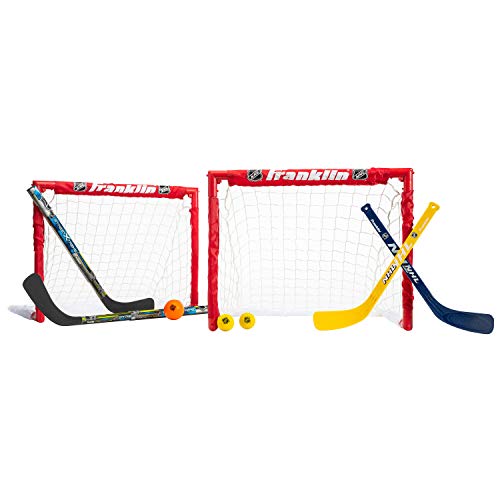Pete's Expert Summary
So, my human has acquired a "Youth Street Hockey Starter Set" from a brand called Franklin Sports. From what I can gather, this is a kit designed to trick small humans into exercising outdoors by giving them long plastic sticks to whack a ball with. The primary appeal for me is, theoretically, the ball. A 65-millimeter, low-density sphere has a certain classic allure. However, the rest of the apparatus is frankly insulting. The sticks are enormous, made of "durable ABS plastic" (which translates to "loud when knocked over"), and are clearly designed for clumsy bipeds to use on pavement, a surface I wouldn't touch with my enemy's paws. This entire endeavor seems geared towards generating noise and sweat, two things that are fundamentally incompatible with a sophisticated lifestyle of napping and judging.
Key Features
- LEARN TO PLAY: The Franklin Future Champs NHL Kids Hockey Stick Set is perfect for teaching your little athletes how to play the sport for the first time
- DURABLE CONSTRUCTION: The shaft and blade are constructed with a flexible and durable ABS plastic to withstand the natural wear and tear that comes with playing outside on pavement
- PROMOTES OUTDOOR PLAY: Including 2 sticks for 1-on-1 play, this hockey stick set promotes outdoor play and can get your little athletes outside and active as they test out and practice their Hockey
- LEFT OR RIGHT HANDED SHOT: Straight blade design so all right-handed and left-handed players can practice and get introduced to the game of street hockey
- Includes- (2) 34 inch junior hockey sticks and (1) 65 millimeter low density street hockey ball
A Tale from Pete the Cat
The monstrosity arrived in a long, thin box that smelled of a factory and disappointment. The human, with the typical lack of ceremony I’ve come to expect, tore it open and presented the contents to a smaller, more chaotic version of himself. Two garishly colored plastic sticks and a lurid orange ball. They were promptly taken outside, where a great deal of shouting and clattering ensued. I watched from the safety of the windowsill, my tail twitching in irritation. It was, as I suspected, a pointless and noisy affair. Eventually, the sticks were brought back inside, smelling of sun-warmed asphalt, and leaned against the wall in the den, forgotten. That night, as I made my rounds inspecting the silent domain, I came upon the abandoned sticks. They stood there, two unnatural pillars in the quiet dark. I regarded them with disdain. They were implements of chaos, tools of the unsophisticated. Yet, as I circled one, my whiskers brushing its smooth, cool shaft, I noticed something. The way it was balanced, leaning just so against the wall, presented a unique architectural challenge. It formed a perfect, 34-inch hypotenuse over a small, empty corner of the room. A corner that was, until now, utterly useless. My mission became clear. This was not a toy. It was a support beam. With the careful precision of a master engineer, I began my work. A gentle nudge here, a calculated shove there. The first stick slid down the wall, landing with a soft *thump* on the carpet. Perfect. I then went to work on the second, pushing its base until it fell across the first, forming a crude but effective A-frame. It was a shelter. A minimalist, post-modern lean-to. I surveyed my creation, a masterpiece of improvised construction. The orange ball, which had rolled nearby, was merely rubble from the project, and I nudged it dismissively into the shadows. I then crept into my newly-formed fortress, curled up beneath the crossed beams of my vanquished foes, and fell into a deeply satisfying, structurally-sound sleep. The sticks weren't for playing; they were for building a better napping spot. Finally, a human purchase with some practical application.









